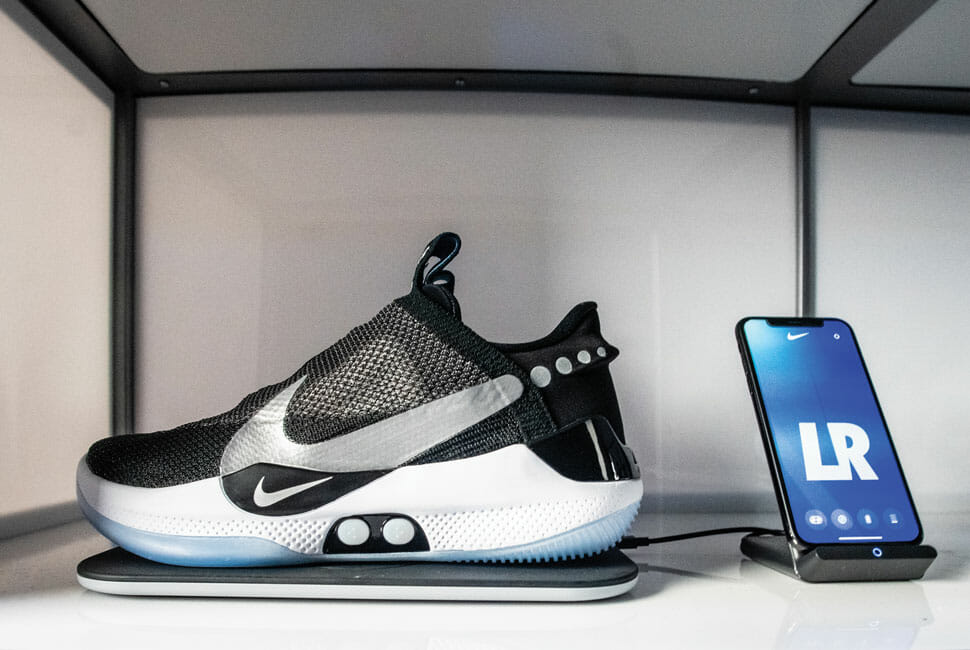Starting the new year on a high note, Nike announced the follow-up to its groundbreaking 2016 self-lacing shoe: a tech-infused, power-lacing basketball shoe called the Adapt BB. It boasts a bevy of advancements but it isn’t the stepping-stone toward a laceless future — which both Nike and other publications have alluded to.
The Oregon-based footwear megabrand claims that the shoelace — a feature of footwear that has endured for millennia — is on the way out, and that its new sneaker signals the start of a radical shift away from laces. To be fair, the Adapt BB is very cool in an Internet-of-things kind of way. But it won’t change the world.
For starters, this isn’t Nike’s first shot at self-lacing kicks. The Hyperadapt 1.0, a shoe that went through 11 years of R&D, came out in 2016 and retailed for $750. It made self-lacing shoes tangible, if slightly out of reach; the mission for the Adapt BB, on the other hand, was far more focused. Nike set out to create a performance basketball shoe to accommodate the demands of players who prefer different fits over the period of wear (e.g. looser pre-game, moderately tight for warm-ups and tighter still for performance). The shoe also needed to be easily adjustable as athletes feet can swell almost a half-size during play.
The resulting Adapt BB sneaker features a power-lacing system built into the sole controllable by touch or an app. It’s relatively intuitive to use: step into the shoe and a motor and gear train tighten an internal lace system until the foot is snug. From there, one can use the FitAdapt tech to make adjustments manually or on the Nike Adapt app, where settings can be stored for later use.

Nike’s product page touts the “distraction-free play” offered by the Adapt BB presuming that players manually adjusting traditional laces is an unwelcome disturbance. And though manually adjusting shoes does shift focus away from other activities, the Adapt BB doesn’t alleviate this hindrance. To adjust fit, players have to reach down to touch the soles of the shoes or otherwise get on their phones to use the app. Either way, the Adapt BB emits two tones during adjustments. It wouldn’t be completely unreasonable to assume a dissonant jumble of tones from a team wearing self-lacing sneakers might be somewhat distracting in a huddle.
What’s more, these sneakers need to be charged. Sure, it’s relatively easy: just place them on a charging mat when not in use. But it’s an added inconvenience over a traditional shoe. What happens when your kicks have a low charge before the big game?
In a statement on Nike’s site, Boston Celtics player Jayson Tatum said, “That the app allows the ability to put the shoe on and touch the button, change the colors, see the percentage on the battery… it’s just cool.” That hits the nail on the head: it is just cool, not a nail in the coffin of traditionally laced shoes.
The connectivity offered is very on-trend, following the overall shift towards an Internet of things, pioneered in the apparel world by garments like the Levi’s Commuter x Jacquard by Google Trucker Jacket. The Nike Adapt app doesn’t just allow the player to control the shoe, it allows them to connect with Nike. Or rather, Nike to “connect” with them. A customer can share data with the brand to help inform updates and receive personal guidance. That guidance, according to the brand, may come in the form of new products and services to help you meet your goals (read: ways to give Nike more revenue). Seems fishy.
So while the Adapt BB is undeniably cool, you’d be wrong to call it a paradigm shift in the footwear world. At $350, they’re a niche experiment, not an accessible sneaker primed to revolutionize the way people wear shoes. Laces are easy, proven and here to stay, at least for the foreseeable millennia.
